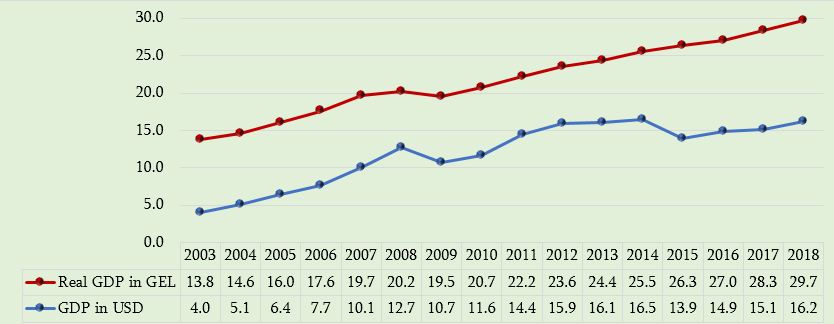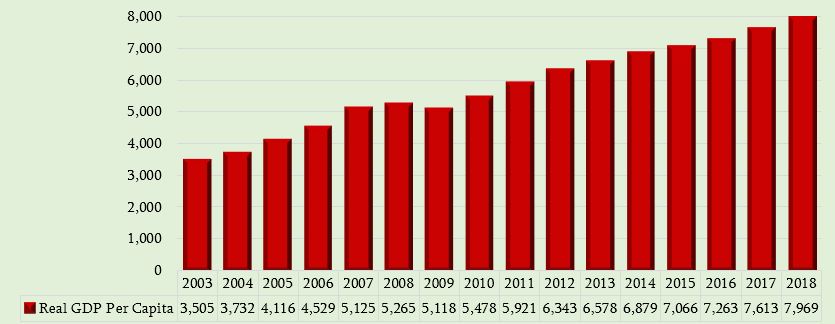Resume: A country’s economy is measured by its gross domestic product (GDP) which indicates the total amount of goods and services produced in a year for final consumption. Of note is that whilst analysing the dynamics of the economy, the GDP should be calculated in a national currency because changes in a foreign currency exchange rate do not automatically imply impoverishment or an economic downturn. In other words, the benefit we receive from the consumption of one kilogram of bread in 2018 is not less as compared to the benefit we received from the consumption of one kilogram of bread in 2012 only because the value of one kilogram of bread in USD is less in 2018. Of note is that the USD exchange rate experienced a global appreciation in 2014 and, therefore, the exchange rate of the currencies of some countries, as well as their GDPs, decreased. Georgia was not an exception. Of course, this effect does not mean a reduction in the economy as the majority of Georgian citizens make most of their economic transactions in GEL. The inflation rate incorporates the impact of the change in the currency exchange rate. Therefore, whilst analysing the dynamics of the economy, it is appropriate to discuss the real GDP[1] because the trend of changes in the real GDP volume is free from the impact of an increased price level and reflects a real picture.
As compared to 2012, Georgia’s real GDP increased by 25% in 2018; that is, Georgia’s economy has not decreased. Similarly, Georgia’s economy in 2003-2012 increased not four-fold but by a factor of 1.7. At the same time, Georgia’s GDP in 2018 constitutes USD 16.2 billion instead of USD 15.7 billion as stated by Giorgi Baramidze. Therefore, not only is the employed approach misleading and wrong, the USD denominated GDP has increased by 2.5% as compared to 2012 and has not decreased even if calculated in this way.
Of note is that Giorgi Baramidze has made a similar statement in the past as well which as per FactCheck’s conclusion was also a manipulation of numbers.
Analysis
Member of the United National Movement’s political council, Giorgi Baramidze, on air on TV Pirveli, stated: “In 2003, Georgia’s economy was USD 4 billion. When we [United National Movement] had left, it was USD 16 billion. The economy increased four-fold. Today, Georgia’s economy is approximately USD 15.7 billion. Georgia’s economy has decreased [as compared to 2012].”
A country’s economy is measured by its gross domestic product (GDP) which indicates the total amount of goods and services produced in a year for final consumption. Of note is that whilst analysing the dynamics of the economy, the GDP should be calculated in a national currency because changes in a foreign currency exchange rate do not automatically imply impoverishment or an economic downturn as the majority of Georgian citizens make most of their economic transactions in GEL. The inflation rate incorporates the impact of the change in a currency exchange rate. Therefore, whilst analysing the dynamics of the economy, it is appropriate to discuss the real GDP which is adjusted to the price level increase (this includes an increase which was caused as a result of changes in the currency exchange rate) indicator and reflects a real picture of the economy.
Graph 1: Real GDP and USD Denominated GDP Dynamic in 2012-2018 (Billion)

Source: National Statistics Office of Georgia
As mentioned by Giorgi Baramidze, Georgia’s USD denominated GDP in 2012 was four times larger as compared to 2003 whilst the GEL denominated GDP in the same period increased by 71%; that is, by a factor of 1.71. As compared to 2012, the real GDP increased by 25% in 2018 which means that Georgia’s economy has not decreased. At the same time, as per the latest data, the 2018 GDP in USD constituted USD 16.2 billion instead of USD 15.7 billion as claimed by the politician. The USD denominated GDP has increased by 2.5% as compared to 2012. In 2014, the USD exchange rate experienced a global appreciation and, therefore, some countries had the exchange rate of their currencies, as well as their GDPs, decreased and Georgia was not an exception in this regard. Of course, this effect does not automatically mean the country’s impoverishment or a reduction in the economy.
In order to have an easier perception of the situation, we can use the following example. If we assume that Georgia consumed just one loaf of bread in 2012, a 25% growth in the real GDP means that the country consumed 1.25 loaves of bread in 2018; that is, Georgia’s well-being increased notwithstanding the value of bread in USD. At the same time, as a result of the changes in the currency exchange rate, the value of one hypothetical unit of a product is USD 0.67 in 2012 whilst it is USD 0.55 in 2018. As claimed by Giorgi Baramidze, we receive less benefit in 2018 as compared to 2012 by consuming the same amount of a product because its USD denominated value has dropped which is an absurd claim. The aforementioned example illustrates that claims of a reduction in the economy are false. Naturally, the benefit from consuming the equal amount of a product would not be different only because its USD denominated value has decreased.
The real GDP per capita is an important indicator when making an analysis of the dynamics of the quality of life. This figure has been increasing constantly throughout 2003-2018. The only exception was when we became poorer in 2009 as a result of objective circumstances. In particular, 2009 was a post-war period which also coincided with the world economic crisis.
Graph 2: Real GDP Per Capita

Source: National Statistics Office of Georgia
As illustrated by the graph, Georgia’s real GDP per capita increased by 81% in 2012 as compared to 2003 whilst the real GDP growth was 25.6% in 2018 as compared to 2012. Of note is that it took nine years for this 81% growth and six years for the 25.6% growth. Of additional importance is the influence of the base effect which is more clearly discernible in the post-revolutionary years.
[1] Real GDP – the total value (in constant prices) of goods and services produced in a year on a country’s territory, intended for final consumption, where the change in price levels is excluded.

![In 2003, Georgia’s economy was USD 4 billion. When we [United National Movement] left, it was USD 16 billion. The economy increased four-fold. Today, Georgia’s economy is approximately USD 15.7 billion. Georgia’s economy has decreased [as compared to 2012](https://factcheck.ge/storage/files/320x180/b4974ea0-c3ef-11e9-b8d9-c780830c812b.jpg)






